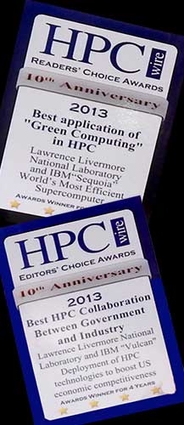LLNL supercomputing recognized at SC13
The Computation Directorate and Advanced Simulation and Computing (ASC) program's effort to make the Lab's Hiigh Performance Computing (HPC) facilities as energy efficient as possible received a Reader's Choice Award, selected by readers of HPCWire. The award was for "Best Application of 'Green Computing' in HPC.
Anna Maria Bailey, LLNL HPC facilities manager, and Becky Springmeyer of ASC, received the award from Tom Tabor, publisher of HPCWire.
Fred Steitz received an Editor's Choice Award from HPCWire editors for the Lab's outreach to industry through the High Performance Computing Innovation Center (HPCIC) and special programs such as the HPC4energy Incubator. Streitz, who is HPCIC director, also received the award from Tabor in DOE's SC13 booth. The award was for "Best HPC Collaboration Between Government and Industry."
On Monday, LLNL computer scientist Dean Williams' climate project was selected for one of the first ever "Enlighten Your Research" collaborations by five of the world's leading national research and education networks (NRENs). Williams was not in attendance to receive the honor and Robin Goldstone of Computation accepted the selection on his behalf.
"International Networking for Climate," led by Williams is a project that complements the Earth System Grid Federation (ESGF) effort, which Williams also leads. This work offers researchers the ability to access climate data at replication sites around the world. These sites include the Program for Climate Model Diagnosis and Intercomparison, or PCMDI, at LLNL; the Center for Environmental Data Archival, or CEDA, UK; the German Climate Computing Center, or DKRZ, DE; the National Computational Infrastructure, Australia; and the Royal Netherlands Meteorological Institute, or KNMI, NL. The goal is to improve the end-to-end Internet connections between sites to 4 gigabits per second (Gbps) by 2014. For more see the Web.
Release of the new Top500 list Monday of the world's most powerful HPC systems proved anticlimactic with no change in the top five systems on the list from June of this year. The list is released twice a year in June and November. Sequoia remains No. 3 on the list. Vulcan, a 5 petaflop (quadrillion floating operations per second), dropped from No. 8 to No. 9 on the new list. For the complete list, see the Web.
Contact
Don Johnston[email protected]
925-423-4902
Related Links
Top500Enlighten Your Researc h
Tags
HPC, Simulation, and Data ScienceSupercomputing
Computing
Featured Articles









